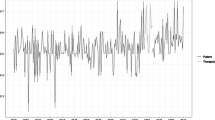Abstract
This study assessed the relative utility of audio and audiovisually recorded versions of structured interactions from the Behavioral Assertiveness Test-Revised. The subjects were 28 adult male psychiatric patients who participated in an assertion training program. The systems were evaluated on a number of dimensions including reliability, comparability, sensitivity to change, concurrent and discriminant validity, and cost. The two systems were found to be approximately equally reliable, to produce comparable results on measures that were assessed by both systems, and to be approximately equally sensitive to change. The main advantage of the audiovisual system was the inclusion of a measure of eye contact — which proved to be one of the most valid component behaviors assessed. Potential users need to weigh the additional information obtained from this measure against the substantially greater cost of the audiovisual system. It was concluded that both systems could be simplified, and limitations of the study were noted.
Similar content being viewed by others
References
Alberti, R. E., & Emmons, M. L.Your perfect right: a guide to assertive behavior 3rd ed. San Luis Obispo, Calif.: Impact Press, 1978.
Baer, D. M. Reviewer's comment: Just because its reliable doesn't mean you can use it.Journal of Applied Behavior Analysis 1977,10 117–119.
Bellack, A. S. A critical appraisal of strategies for assessing social skill.Behavioral Assessment 1979,1 157–176.
Bellack, A. S., Hersen, M., & Turner, S. M. Role-play tests for assessing social skills: are they valid?Behavior Therapy 1978,9 448–461.
Bellack, A. S., Hersen, M., & Lamparski, D. Role play tests for assessing social skills: Are they valid? Are they useful?Journal of Consulting and Clinical Psychology 1979,47 335–342.
Campbell, D. T., & Fiske, D. W. Convergent and discriminant validation by the multitrait-multimethod matrix.Psychological Bulletin 1959,56 81–105.
Clement, P. G. A formula for computing interobserver agreement.Psychological Reports 1976,39 257–258.
Curran, J. P. Comments on Bellack, Hersen, and Turner's on the validity of role-play tests.Behavior Therapy 1978,9 462–468.
Curran, J. P. Pandora's box reopened? The assessment of social skills.Journal of Behavioral Assessment 1979,1 55–71.
Eisler, R. M. The behavioral assessment of social skills. In M. Hersen, & A. S. Bellack (Eds.),Behavioral assessment: a practical handbook. Elmsford, N.Y.: Pergamon, 1976.
Eisler, R. M., Hersen, M., & Agras, W. S. Videotape: a method for the controlled observation of nonverbal interpersonal behavior.Behavior Therapy 1973,4 420–425.
Eisler, R. M., Hersen, M., Miller, P. M., & Blanchard, E. B. Situational determinants of assertive behavior.Journal of Consulting and Clinical Psychology 1975,43 330–340.
Eisler, R. M., Miller, P. M., & Hersen, M. Components of assertive behavior.Journal of Clinical Psychology 1973,29 295–299.
Gay, M. L., Hollandsworth, J. G., Jr., & Galassi, J. P. An assertiveness inventory for adults.Journal of Counseling Psychology 1975,22 340–344.
Gormally, J., Hill, C. E., Otis, M., & Rainey, C. A microtraining approach to assertion training.Journal of Counseling Psychology 1975,22 299–303.
Harris, F. C., & Lahey, B. B. A method for combining occurrence and nonocurrence interobserver agreement scores.Journal of Applied Behavior Analysis 1978,11 523–527.
Hartmann, D. P. Considerations in the choice of interobserver reliability estimates.Journal of Applied Behavior Analysis 1977,10 103–116.
Hartmann, D. P., Roper, B. L., & Bradford, D. C. Some relationships between behavioral and traditional assessment.Journal of Behavioral Assessment 1979,1 3–21.
Heimberg, R. G., Montgomery, D., Madsen, C. H., Jr., & Heimberg, J. S. Assertion training: a review of the literature.Behavior Therapy 1977,8 953–971.
Hersen, M., & Bellack, A. S. Assessment of social skills. In Ciminero, A. R., Calhoun, K. S., & Adams, H. E. (Eds.),Handbook of behavioral assessment. New York: Wiley, 1977.
Kazdin, A. E. Covert modeling, imagery assessment, and assertive behavior.Journal of Consulting and Clinical Psychology 1975,43 716–724.
Lange, A. J., & Jakubowski, P.Responsible assertive behavior: cognitive/behavioral procedures for trainers. Champaign, Ill.: Research Press, 1976.
McFall, R. M., & Marston, A. R. An experimental investigation of behavior rehearsal in assertive training.Journal of Abnormal Psychology 1970,76 295–303.
McFall, R. M., & Lillesand, D. B. Behavioral rehearsal with modeling and coaching in assertion training.Journal of Abnormal Psychology 1971,77 313–323.
Nietzel, M. T., Matorano, R. D., & Melnick, J. The effects of covert modeling with and without reply training on the development and generalization of assertive responses.Behavior Therapy 1977,8 70–79.
Reid, J. B. Reliability assessment of observation data: a possible methodological problem.Child Development 1970,41 1143–1150.
Rich, A. R., & Schroeder, H. E. Research issues in assertiveness training.Psychological Bulletin 1976,83 1081–1096.
Shipley, W. C.Shipley institute of living scale for measuring intellectual impairment: manual of directions and scoring key. Hartford, Conn.: The Institute for Living, 1939.
Author information
Authors and Affiliations
Rights and permissions
About this article
Cite this article
Glasgow, R.E., Ely, R.O., Besyner, J.K. et al. Behavioral measures of assertiveness: A comparison of audio and audiovisual coding of structured interactions. Journal of Behavioral Assessment 2, 273–285 (1980). https://doi.org/10.1007/BF01666786
Accepted:
Issue Date:
DOI: https://doi.org/10.1007/BF01666786




